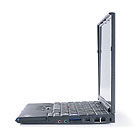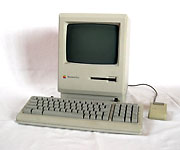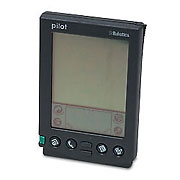The 50 Best Tech Products of All Time
By Christopher Null, PC World
Page 2 of 5

11. Adobe Photoshop 3.0 (1994)
Photoshop has been a killer app since its introduction on the Mac in 1988, but it wasn't until years later that this watershed graphics tool became a must-have for design professionals. That adoption began in earnest with Photoshop 3.0 and the introduction of layers, which allowed designers to play with images and effects on multiple levels, one atop another, rather than in a single flat dimension. This technology opened the door for image manipulation on a much grander scale than had been possible before--and it's also why you'll never be able to trust a photograph again. Adobe's most recent versions, Photoshop CS2 and Photoshop CS3 carry on the original software's tradition and remain the standard for the field.

12. IBM ThinkPad 700C (1992)
For many years, only one name mattered when it came to laptops, and that was IBM. With every ThinkPad release, IBM continued to amaze the market, each system outshining its predecessor with a lighter weight, more power, or a larger screen than had previously been thought possible. The 701C, for example, offered an expanding, full-size "butterfly" keyboard that was so innovative it ended up on display at the Museum of Modern Art in New York. The machine that started it all, however, was the 700C, which weighed less than 6 pounds, had a huge-for-its-time 10.4-inch color TFT display, and featured the first-ever pointing stick. Although the laptop is now owned by Chinese company Lenovo, ThinkPads like the R60 are still coveted status symbols in the business community.

13. Atari VCS/2600 (1977)
You can't underestimate the importance of the original Atari, which made home gaming what it is today. All modern game consoles owe some part of their heritage to this machine of simple design (not to mention awesome wood-grain paneling). The VCS (later renamed the 2600) was a cool curiosity (until Space Invaders arrived in 1980), with sales hitting 8 million units in 1982 alone. The 2600 eventually sold about 40 million units, and paved the way for all manner of competitors and imitators. Along with the original Pong, it remains the only truly important product that Atari ever released.

14. Apple Macintosh Plus (1986)
Two years after the release of the first Macintosh computer, Apple finally hit its stride with the venerable Mac Plus , which corrected several defects of the original Mac and became one of the company's most-loved (and used) products. The stylish all-in-one box featured a Motorola 68000 processor, a built-in 9-inch monochrome display, and a 3.5-inch floppy drive. Chief among its innovations was a SCSI port so you could attach an external hard drive, and 1MB of RAM, which was upgradable to 4MB. Computer as fashion status symbol? Today's iMacs have style to spare, but the Mac Plus is where it all started. While the original Mac Plus sold for a whopping $2600, today you can get one for less than $100 on eBay .

15. RIM BlackBerry 857 (2000)
When RIM introduced the original BlackBerry 850 , the company realized its genius idea of turning the standard two-way pager into something a little more full-featured. The 850 was able to send and receive e-mail--which you could type with your thumbs on its tiny QWERTY keyboard, though the six- or eight-line display left little room for navigating through messages. Enter the BlackBerry 857 , which was basically the same device but which offered up to 20 lines of text. The oblong form factor also got designers thinking that the BlackBerry might not make such a bad cell phone. RIM's first combination e-mail/phone device arrived two years later, and the 857's design still influences the look of many current smart phones , and its heritage can clearly be seen in today's BlackBerry 8700c .

16. 3dfx Voodoo3 (1999)
Arguments about the best video card of all time can quickly degenerate into schoolyard shoving matches, but few will dispute that 3dfx's Voodoo3 cards were some of the most important ones ever made. Most notably, they had a virtual monopoly at the time on games that used multiple texturing, including Quake 3, and 3dfx even created a custom API called Glide for developers to use when coding games. The Voodoo3 was a huge success, but 3dfx was soon on the ropes. Glide faded from use, follow-up products were disastrous, and the company burned so much cash that it was nearly dead (its corpse picked over by nVidia) a year later.

17. Canon Digital Elph S100 (2000)
Early digital cameras weren't much to look at: They were large, clunky, and utterly lacking in aesthetics. But the original Digital Elph changed all that. Clad in stainless steel and almost impossibly small, Canon's S100 showed how sophisticated a pocket camera could look. Yet it didn't compromise on features, offering a 2.1-megapixel CCD, a 2x optical zoom lens, and autofocus. Today, digicams continue to take design cues from the Elph; Canon's pocket cameras and its current Elph model, the PowerShot SD630 , still maintain the overall look of the original model.

18. Palm Pilot 1000 (1996)
The Palm Pilot 1000 wasn't the first PDA, but it was the first one that mattered. Having taken a cue from the rapidly declining fortunes of the Apple Newton, Palm set out to design a portable personal digital assistant that focused first and foremost on pocketability. The original model was so influential that the name "Palm Pilot" has stuck with the series, even though the "Pilot" part was banished in 1998. Numerous aspects of the original Palm operating system, including its iconic layout, can still be found on contemporary Treos .

19. id Software Doom (1993)
If anti-video-game-violence crusader Jack Thompson is right, most of society's ills can probably be traced back to the watershed video game Doom , which launched the first-person-shooter genre into the stratosphere. A shareware offering, Doom spread rapidly upon release, and gamers thrilled to its (now primitive) 3D graphics and mod capabilities, which let you take on the role of designer and create your own levels. Purists may argue that we should have selected id's Wolfenstein 3D instead; but unlike Doom, it didn't let you wield a chainsaw--possibly the most iconic FPS weapon of all time. Take that, Martian demons! PC versions of Doom certainly live on, but today console and handheld versions are more common.
20. Microsoft Windows 95 (1995)
Yes, we know that plenty of Windows for Workgroups 3.11, Windows 98 SE, and Windows 2000 fans exist, but Windows 95 first brought us long file names, legitimate multitasking, and a dramatically improved GUI, which arguably represents the brief and final moment in time that Windows actually looked better than a Mac.